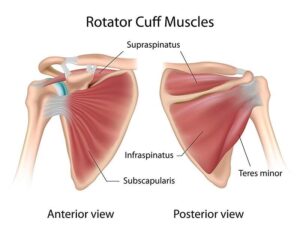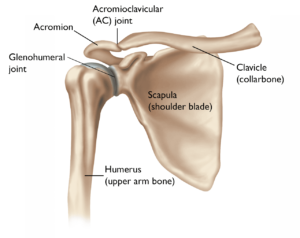Experiencing a shoulder injury during a lifting movement is quite common, especially when lifting repetitively or lifting overhead. Many factors contribute to the risk and development of shoulder injuries during a lifting task, and each should be considered during your recovery.
The shoulder joint is the most mobile joint within the human body.
This mobility has proven to be quite useful in our everyday tasks and recreational activities, especially the ability to lift, reach overhead, and throw. Unfortunately, to offer so much mobility at the shoulder, our body had to sacrifice some stability. Due to this sacrifice, our shoulder joint relies more on ‘dynamic stability,’ the activation of surrounding musculature for support during movement. It’s this active reliance that predisposes our shoulder to increased injury risk during functional tasks, such as lifting, and makes shoulder injuries so common.
Below you’ll find an image of a shoulder joint (figure 1). The two major bones of our shoulder joint include the humerus and our shoulder blade (aka your scapula). These two bones both play an important role in the amount of movement created at your shoulder joint. Many of the important dynamic stabilizers, namely, your rotator cuff, originate from the shoulder blade. Therefore, the scapula acts as a foundation upon which most stability and movement of your shoulder is based upon. Further, as you can see, where these two bones meet is a very shallow, poorly congruent joint which contributes very limited ‘structural stability’ to the joint due to their shape.
Thankfully, your shoulder is surrounded by a cartilaginous labrum, ligaments, and tendons that create the stability of your joint while still allowing for 180 degrees of motion. However, it is the lack of this bony stability that greatly increases our dynamic stability from surrounding musculature to create stability, especially when under load.
https://orthoinfo.aaos.org/en/diseases–conditions/arthritis-of-the-shoulder
Rotator Cuff: What is it and what does it do?
The rotator cuff is a group of muscles that bear the greatest responsibility in creating dynamic stabilization of the shoulder during lifting and overhead tasks. The rotator cuff musculature, namely: supraspinatus, infraspinatus, teres minor, and subscapularis, attach discretely around all sides of your humeral head but function together to maintain stability during motion (figure 2).

https://www.joionline.net/trending/content/rotator-cuff-tears
Research shows that an increase in either load or height will greatly increase the demand and activation of your rotator cuff musculature. However, this increase is not limited to the rotator cuff alone. Further shoulder stabilizers, such as the anterior deltoid and upper fibers of trapezius, contribute greatly to the active stability required during lifting tasks. Therefore, during any weighted lifting task we increase the demand placed upon our shoulder girdle musculature, especially when lifting a load or to a greater height which may lead to injury.
Additionally, another important factor to consider in figure 2 is how all four muscles of our rotator cuff originate on the shoulder blade. This fact, in combination with its important contribution to motion at the glenohumeral joint, makes the shoulder blade and the stability of our shoulder blade an important component during lifting tasks as well. Did you know, full shoulder elevation (overhead reach) requires a 2:1 ratio of movement between your humerus and your shoulder blade? Therefore, proper posture, upper back strength, and mobility of your shoulder blade contribute greatly to lifting tasks but also the risk of injury development during the same.
Signs and Symptoms of a Shoulder / Rotator Cuff Strain
While the symptoms experienced will vary depending on the severity of your shoulder injury from fall and the structures involved, common signs and symptoms of a rotator cuff strain may include:
- Pain in the shoulder or upper arm
- Pain with active movements, such as: reaching overhead, lifting laterally, or behind your back
- Generalized ache / sharp pain with certain movements
- Tenderness to touch
- Rest pain or night pain
Are there other factors that could contribute to my injury?
Many factors contribute to the development of a shoulder injury or increase your risk of experiencing a shoulder injury from lifting, either a single event or repetitively. This includes:
- Age,
- Posture,
- Repetitive use,
- General health,
- Muscular imbalances.
Healing timelines will be impacted by the number of factors contributing to the injury, injury severity, and the specific structure involved. Muscular healing timelines, if you experienced a rotator cuff strain will likely occur between 6 – 8 weeks depending on appropriate management and care.
What To Do When You Have Shoulder Injury From Lifting?
Due to the complexity of the shoulder joint and the number of factors that may have contributed to your injury, a thorough clinical history, and physical examination would be the most accurate way to determine the next steps in your rehabilitation.
An important first step following any injury is identifying the nature and severity of the condition. Although the rotator cuff plays an important part in lifting, several other structures may have been affected during a lifting task. This includes a bursitis, injury to ligaments, labrum, or bone.
In the initial days following your injury or while awaiting your PT appointment, you can try managing your pain with:
- Ice
- Supporting your arm when not in use (pillows, etc)
- Pain-free range of motion
- Avoid repetitive and aggravating motions.
Physiotherapy is considered a first-line treatment for most non-traumatic shoulder injuries2 as your PT will assess your joint mobility, identify any muscular imbalances, and address any postural discrepancies. A physiotherapist can help you determine a safe and effective exercise program to strengthen your shoulder and scapular stabilizers to appropriately address your injury.
References
Blache, Y., Desmoulins, L., Allard, P., Plamondon, A., & Begon, M. (2015). Effects of height and load weight on shoulder muscle work during overhead lifting task. Ergonomics, 58(5), 748-761.
Brown, G., Park, K., & Bicknell, R. T. (2015). Management of occupational shoulder injuries in primary care. Journal Musculoskeletal Disorders & Treatment, 1(002).
Howe, L. P., & Blagrove, R. C. (2015). Shoulder function during overhead lifting tasks: implications for screening athletes. Strength & Conditioning Journal, 37(5), 84-96.

